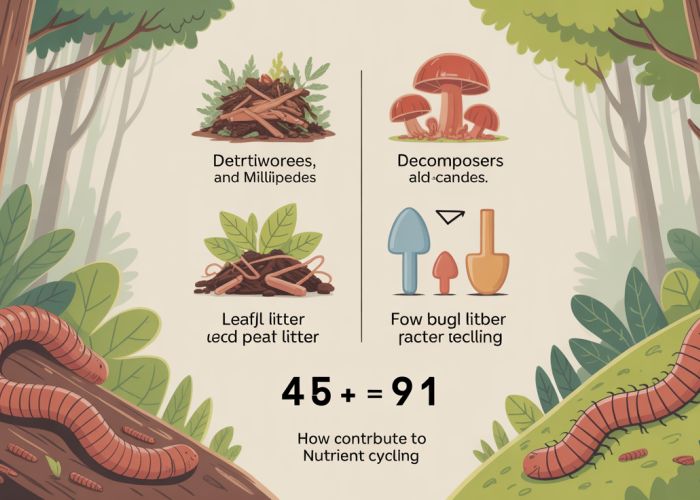The intricate web of life relies on efficient recycling, a process where detritivores vs decomposers play a crucial role. Ecosystems, dynamic and self-regulating, depend on these organisms to break down organic matter. Fungi, acting as decomposers, secrete enzymes to dissolve organic material externally. Meanwhile, earthworms, quintessential detritivores, ingest and internally process dead plant and animal matter, contributing to soil aeration. A deep understanding of nutrient cycling illuminates the functional differences that define detritivores vs decomposers.

Detritivores vs. Decomposers: Who Cleans Up Nature’s Mess?
Nature operates a continuous recycling program, breaking down organic matter and returning essential nutrients to the ecosystem. Two key players in this cleanup crew are detritivores and decomposers. Although both contribute to decomposition, they operate through distinct mechanisms and target different stages of the process. Understanding the difference between detritivores vs decomposers is crucial for appreciating the intricate web of life and the flow of energy within an environment.
Defining Detritivores: Nature’s Shredders
Detritivores are organisms that consume dead organic matter, known as detritus. This matter includes dead plants, animal carcasses, fallen leaves, and fecal waste. Think of them as nature’s shredders, physically breaking down large pieces of organic material into smaller fragments.
Examples of Detritivores
- Earthworms: These soil dwellers ingest decaying plant matter, aerating the soil and enriching it with their castings.
- Millipedes: These segmented invertebrates feed on decaying leaves and wood, further breaking them down.
- Sea Stars: Some sea stars consume dead organisms on the ocean floor.
- Dung Beetles: These beetles feed on animal dung, playing a vital role in nutrient cycling in grasslands.
- Woodlice: These crustaceans consume decaying plant material in damp environments.
The Detritivore Process
- Consumption: Detritivores ingest detritus, physically breaking it down into smaller pieces.
- Digestion: They extract nutrients from the detritus through digestion.
- Excretion: The undigested material is excreted as waste, which is often further broken down by decomposers.
Defining Decomposers: The Chemical Recyclers
Decomposers, primarily bacteria and fungi, break down dead organic matter through chemical means. They secrete enzymes that break down complex organic compounds into simpler inorganic substances. This process releases nutrients back into the soil, air, and water, making them available for plants and other organisms.
Examples of Decomposers
- Bacteria: These microscopic organisms are essential for decomposing organic matter in various environments.
- Fungi: Fungi, such as molds and mushrooms, play a crucial role in breaking down complex organic compounds like cellulose and lignin found in plant matter.
The Decomposition Process
- Enzyme Secretion: Decomposers release enzymes into their surroundings.
- Breakdown: These enzymes break down complex organic molecules in detritus into simpler inorganic substances.
- Absorption: Decomposers absorb these simpler substances as nutrients.
- Nutrient Release: In the process, nutrients are released back into the environment.
Key Differences Between Detritivores vs Decomposers
The primary difference between detritivores vs decomposers lies in their method of breaking down organic matter: detritivores physically break it down, while decomposers chemically break it down.
| Feature | Detritivores | Decomposers |
|---|---|---|
| Mechanism | Physical breakdown (ingestion & excretion) | Chemical breakdown (enzyme secretion) |
| Organisms | Earthworms, millipedes, dung beetles, etc. | Bacteria, fungi |
| Material Size | Larger pieces of detritus | Smaller, partially decomposed matter |
| End Product | Smaller detritus fragments, fecal matter | Inorganic nutrients |
| Environmental Role | Fragmentation and nutrient release | Nutrient recycling and mineralization |
The Interconnected Roles of Detritivores and Decomposers
Detritivores and decomposers work synergistically in the ecosystem. Detritivores prepare the ground by physically breaking down large pieces of organic matter, increasing the surface area available for decomposers to act upon. The waste products of detritivores also provide a more readily accessible food source for decomposers. In this way, both are essential for complete and efficient decomposition and nutrient cycling. The combined action of detritivores vs decomposers drives the continuous recycling of matter and the sustenance of life.
Detritivores vs. Decomposers: Frequently Asked Questions
Here are some common questions about the differences between detritivores and decomposers and their vital roles in ecosystems.
What’s the main difference between detritivores and decomposers?
Detritivores are animals that eat dead organic matter, physically breaking it down. Decomposers, like bacteria and fungi, break down dead organic matter chemically, absorbing nutrients. In essence, detritivores eat the mess, while decomposers dissolve it.
Do detritivores and decomposers compete with each other?
Not directly. Detritivores create smaller pieces of organic matter, making it easier for decomposers to do their work. In the detritivores vs. decomposers relationship, they often work sequentially in a symbiotic way.
Can something be both a detritivore and a decomposer?
Generally, no. Detritivores are typically animals that ingest matter. Decomposers are usually microorganisms that secrete enzymes to digest matter externally. While some organisms might play overlapping roles, they are primarily classified as either one.
Why are detritivores and decomposers important for the environment?
Detritivores and decomposers recycle nutrients back into the ecosystem. Without detritivores vs decomposers, dead plant and animal matter would accumulate, and nutrients essential for new life wouldn’t be available. This would disrupt the entire food web.
So, next time you’re out in nature, take a moment to appreciate the unsung heroes working tirelessly to keep things tidy! Hopefully, you now have a clearer picture of the difference between detritivores vs decomposers and how they both contribute to a healthy ecosystem. Keep exploring!



